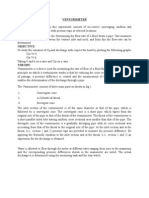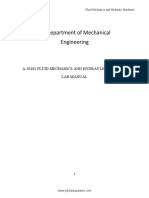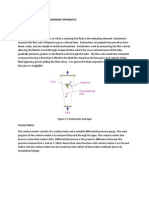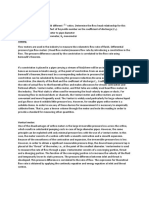Experiment No 3 HM Lab
Experiment No 3 HM Lab
Uploaded by
prajwalwanjari5524Copyright:
Available Formats
Experiment No 3 HM Lab
Experiment No 3 HM Lab
Uploaded by
prajwalwanjari5524Original Description:
Original Title
Copyright
Available Formats
Share this document
Did you find this document useful?
Is this content inappropriate?
Copyright:
Available Formats
Experiment No 3 HM Lab
Experiment No 3 HM Lab
Uploaded by
prajwalwanjari5524Copyright:
Available Formats
EXPERIMENT NO: 3
AIM: To determine coefficient of discharge of Orifice meter.
OBJECTIVES:
➢ To measure the volume flow rate or discharge through a pipe having a pressurized fluid flow.
➢ To comprehend the abstraction of vena contracts in pipe flows.
➢ To determine the coefficient of discharge of an orifice meter.
APPARATUS
➢ Orifice meter
➢ Piping System
➢ Supply Pump Set
➢ Measuring Tank
➢ Differential Manometer
➢ Sump
➢ Stop Watch
THEORY
An orifice plate is a device used for measuring the volumetric flow rate. It uses the same principle as a
Venturi nozzle, namely Bernoulli's principle which states that there is a relationship between the pressure
of the fluid and the velocity of the fluid. When the velocity increases, the pressure decreases and vice versa.
An orifice plate is a flat circular thin plate which has a circular sharp-edged hole called orifice. It is an
opening in the side or bottom of a vessel or a tank through which liquid will flow under the condition that
the liquid surface is always above the top edge of the opening.
The orifice diameter is 0.5 times the diameter of the pipe. A differential manometer is connected at section
1 which is at a distance of about 1.5 to 2 times the pipe diameter upstream from the orifice plate, and at
section 2, which is at a distance of about half the diameter of the orifice on the downstream side from the
orifice plate.
The basic principle on which an orifice meter works is that by reducing the cross-sectional area of the flow
of passage, a pressure difference between the two sections is developed and the measurement of the pressure
difference enables the determination of the discharge through pipe.
However, an orifice meter is a cheaper arrangement for discharge measurement through pipes and its
installation requires a smaller length as compared to venturi meter.
The differential pressure head is measured using a manometer and the discharge through the pipe cross-
section can easily be calculated.
Department of Mechanical Engineering Metrology and Quality Control Lab
The figure above shows an orifice meter connected in a pipe of diameter D containing a fluid flowing under
the influence of pressure forces.
The theoretical discharge through the pipe cross-section can be calculated as;
D =Diameter of pipe
A1 = Area of pipe at inlet
do = Diameter of orifice
A2 = Area of pipe at orifice
h = Pressure head difference in the limbs of manometer
h = x (Sm /S – 1)
Where,
x = difference between the liquid column in U tube,
Sm = Specific Gravity of manometric liquid,
S = Specific Gravity of liquid flowing through pipe.
The actual discharge can be determined by recording the time to fill a known volume of fluid in the
volumetric tank.
Department of Mechanical Engineering Metrology and Quality Control Lab
VENA CONTRACTA
When an orifice meter is installed in a pipe, the cross-section contracts. Consequently, the streamlines come
close to each other. The section where the streamlines come the closest possible is termed the vena contracta.
The velocity of fluid at this section shows an instantaneous hike followed by a pressure decrement.
The figure above shows the graphical trend of pressure variation across the orifice plate. It can be seen that
at the contracted section, the pressure magnitude is the least after which the pressure head is restored but to
decremented value in comparison to the pressure at the inlet. This is because of frictional losses incurred as
the fluid traverses the pipe length.
COEFFICIENT OF DISCHARGE, Cd
The coefficient of discharge of an orifice meter is the ratio of the actual discharge to the theoretically-
calculated volume flow rate. Mathematically, it is given as;
PROCEDURE
• Start the pump and by using the discharge control valve, adjust the flow rate and measure it by
noting down the time taken (t) to fill the volumetric tank in the hydraulic bench to a known depth.
• Calculate the actual discharge as follows;
Q = V/t = (A×R)/t
• Before allowing the fluid to flow into the orifice meter apparatus, ensure that the pipelines are free
from air bubbles. To do so, turn on the air-release valves to allow the air bubbles to traverse the pipe
length to enter the tank.
• Open the valve of the orifice meter pipeline to allow water to flow through the orifice plate.
• The manometer present below shows a pressure drop. Record the level of manometric fluid in both
limbs of the manometer in order to determine the differential pressure head.
Department of Mechanical Engineering Metrology and Quality Control Lab
• Calculate the theoretical discharge.
• Determine the coefficient of discharge of the orifice meter by taking the ratio of actual discharge to
the theoretical one.
• Repeat the above process for a different discharge value. To alter the flow rate, rotate the discharge
control valve either clockwise or anticlockwise.
• Average out the value of the coefficient of discharge of the orifice meter.
OBSERVATION TABLE
Tank Level
S. No. Time (sec.)
H1 (cm) H2 (cm)
1 0 3.5
2 3.5 7.0
3 7.0 10.5
Sr. Level of Differential Volume Time Theoretical Actual Coefficient
No. manometric Pressure (V) Discharge Discharge of
fluid (cm) Head, h (t) Discharge
3
(cm) (cm ) Qth Qact
Left Right (sec) Cd
Limb Limb (cm3/s) (cm3/s)
(h1) (h2)
1.
2.
3.
FORMULAES USED:
1. Calculate actual discharge using below formula.
Actual Discharge: - The time taken to collect some, R cm of water in the collecting tank in m³/sec.
Where,
A = area of the collecting tank in m² (30 cm × 28 cm)
R = rise of water level taken in meters (3.5 cm) (H2 – H1)
t = time taken for rise of water level to rise in seconds.
2. Using difference in mercury level “x”, calculate the theoretical discharge of orificemeter by using
following expression
Department of Mechanical Engineering Metrology and Quality Control Lab
Where,
h = difference of head in meters = (h2 – h1) × (Sm /S – 1)
= (h2 – h1) ×12.6 m
A1 = Area of at inlet = (π/4)*d12 A2 = Area1 of orifice = (π/4)*d2
2
g = acceleration due to gravity d1 = inlet/pipe diameter = 2.8 cm
d2 = orifice diameter = 1.45 cm Sm = Specific gravity of mercury =13.6
Sw = Specific gravity of water = 1
3. Calculate the coefficient of discharge of orifice meter Cd = Qac / Qth
RESULTS
Coefficient of Discharge of the orifice meter = ………………………
PRECAUTIONS
• The availability of water in the sump tank should be ensured prior to pumping the water.
• The meniscus of the manometer should be read carefully.
• It is preferable to wear safety goggles and gloves while handling hydraulic fluids.
• It is imperative to remove the air bubbles in the pipelines that may otherwise yield misleading
results.
DISCUSSION
• The coefficient of discharge of an ideal pipe is 1. This is because the theoretical and actual flow rate
values coincide. However, the existence of such a pipe is hypothetical and energy or frictional losses
during the flow of fluid can be minimized but not eliminated.
• Depending upon the viscosity of the fluid and its Reynold number, different types of orifice plates
can be used. These include segmental, eccentric, conical, and quadrant orifice plates.
• Orifice meters can serve to measure the discharge through water treatment plants, filtration plants,
oil refineries, etc.
• Make sure while taking readings, that the manometer is properly primed. Priming is the operation of
filling the manometer’s upper part and the connecting pipes with water by venting the air from the
pipes.
Department of Mechanical Engineering Metrology and Quality Control Lab
You might also like
- Calibration of Venturi MeterDocument9 pagesCalibration of Venturi Meterseminarproject50% (6)
- 02 Venturi MeterDocument5 pages02 Venturi MeterMehedi Hasan0% (1)
- Calibration of An Orifice and Venturi Meter PDFDocument20 pagesCalibration of An Orifice and Venturi Meter PDFjamaiiicaNo ratings yet
- LAB MANUAL. EXPERIMENT 2. Calibration of Venturi MeterDocument3 pagesLAB MANUAL. EXPERIMENT 2. Calibration of Venturi Meterjames PrincipeNo ratings yet
- Mazda 32318 I 16 VBPDocument49 pagesMazda 32318 I 16 VBPJon Luc Pulido Julian0% (2)
- VENTURIMETERDocument4 pagesVENTURIMETERKailash RajuNo ratings yet
- Fluid Lab ManualDocument27 pagesFluid Lab ManualvenkiteshksNo ratings yet
- Calibration of VenturimeterDocument5 pagesCalibration of VenturimeterRahul KumarNo ratings yet
- Experiment No.: 10 Name of Experiment: To Determine Coefficient of Discharge of Rotameter Roll No: Batch: DateDocument3 pagesExperiment No.: 10 Name of Experiment: To Determine Coefficient of Discharge of Rotameter Roll No: Batch: DateSanjay IngaleNo ratings yet
- Determination of The Coefficient of Discharge of Given Orifice MeterDocument62 pagesDetermination of The Coefficient of Discharge of Given Orifice MeterPandiya RajanNo ratings yet
- Fallsem2021-22 Che1005 Ela Vl2021220101507 Reference Material I 11-Aug-2021 1.flow Through VenturimeterDocument4 pagesFallsem2021-22 Che1005 Ela Vl2021220101507 Reference Material I 11-Aug-2021 1.flow Through Venturimeterkeerthana satheeshNo ratings yet
- Calibrating The Venturi Meter and Orifice MeterDocument6 pagesCalibrating The Venturi Meter and Orifice MeterMUTHUKURU VENKATA GOWTHAM REDDY100% (1)
- Fluid Dynamics Student ManualDocument70 pagesFluid Dynamics Student ManualJayachandran SivagurunathanNo ratings yet
- Discharge CoefficientDocument11 pagesDischarge Coefficientsisai12u2420% (2)
- Orifice Plate Long ReportDocument16 pagesOrifice Plate Long ReportLuqman HakimNo ratings yet
- Experiment 1 - Calibrating The Venturi Meter and Orifice MeterDocument4 pagesExperiment 1 - Calibrating The Venturi Meter and Orifice Meterf20221047No ratings yet
- Venturimeter, Orificemeter & Rotameter Calibration Set-Up: Experiment No. 4Document9 pagesVenturimeter, Orificemeter & Rotameter Calibration Set-Up: Experiment No. 4Somya MaheshwariNo ratings yet
- Fallsem2019-20 Che1005 Ela Vl2019201002671 Reference Material Momentum Lab ManualDocument43 pagesFallsem2019-20 Che1005 Ela Vl2019201002671 Reference Material Momentum Lab ManualermiasNo ratings yet
- Flow of Water by Notch and WeirsDocument17 pagesFlow of Water by Notch and WeirsMuhammad Zulhusni Che RazaliNo ratings yet
- Lab ManualDocument46 pagesLab ManualAizaz HabibNo ratings yet
- 1 Calibrating The Venturi Meter and Orifice MeterDocument5 pages1 Calibrating The Venturi Meter and Orifice MeterRaghavanNo ratings yet
- Fluid Mechanics and Hydraulic Machines Lab Manual PDFDocument55 pagesFluid Mechanics and Hydraulic Machines Lab Manual PDFjyothiNo ratings yet
- Im316 Flow MeasurementDocument67 pagesIm316 Flow MeasurementSelvarajNo ratings yet
- 3 OrificesDocument7 pages3 OrificesPraful N KNo ratings yet
- 1ST Phase Labs - Applied ThermodynamicsDocument21 pages1ST Phase Labs - Applied Thermodynamicsf20231043No ratings yet
- Venturi MeterDocument8 pagesVenturi MeterSwati SachanNo ratings yet
- Ce8381 FMDocument65 pagesCe8381 FMAyyanrajNo ratings yet
- Calibration of VenturimeterDocument5 pagesCalibration of VenturimeteramarparimiNo ratings yet
- Closed Circuit Venturimeter AimDocument3 pagesClosed Circuit Venturimeter Aimsaggam indureddyNo ratings yet
- Friction of Pipe 2Document5 pagesFriction of Pipe 2Ranu GamesNo ratings yet
- Lab Manual of Hydraulics PDFDocument40 pagesLab Manual of Hydraulics PDFJULIUS CESAR G. CADAONo ratings yet
- Experiment No. 6: Department of Mechanical Engineering MKSSS's Cummins College of Engineering For WomenDocument7 pagesExperiment No. 6: Department of Mechanical Engineering MKSSS's Cummins College of Engineering For WomenSafeer MNo ratings yet
- Notch and WeirsDocument33 pagesNotch and WeirsAbdur RashidNo ratings yet
- VENTURIMETERDocument17 pagesVENTURIMETERPankaj JenaNo ratings yet
- Venturi MeterDocument4 pagesVenturi Meterprince.patelNo ratings yet
- User Manual Closed Circuit Venturimeter Test Rig & Orifece Meter Test RigDocument7 pagesUser Manual Closed Circuit Venturimeter Test Rig & Orifece Meter Test Rigrohit kumarNo ratings yet
- FM Lab PDFDocument29 pagesFM Lab PDFamitNo ratings yet
- Orifcie Sizing CalulationDocument25 pagesOrifcie Sizing Calulationmgkvpr100% (1)
- Calibration of Orifice MeterDocument5 pagesCalibration of Orifice Meteramarparimi67% (3)
- Experiment 1, Flow Over A V Notch WeirDocument6 pagesExperiment 1, Flow Over A V Notch WeirGaggiNo ratings yet
- Fluid Mechanics-II New WorkbookDocument50 pagesFluid Mechanics-II New WorkbookMr. Muhammad Hassam SiddiquiNo ratings yet
- Venturimeter Exp. 250412Document4 pagesVenturimeter Exp. 250412abhishekpatil21No ratings yet
- Venturi ReportDocument8 pagesVenturi Reportstephen kangereNo ratings yet
- Venturi MeterDocument4 pagesVenturi MeterJorah MormontNo ratings yet
- Topic 2: Flowmeter Measurement Apparatus 2.1 THEORY: RotameterDocument6 pagesTopic 2: Flowmeter Measurement Apparatus 2.1 THEORY: Rotameterpelinces_cityNo ratings yet
- FM Lab Manual 24-25Document54 pagesFM Lab Manual 24-25sachinsiddharth003No ratings yet
- FLUID MECHANICS Lab ManualDocument65 pagesFLUID MECHANICS Lab ManualPaulNo ratings yet
- Hydraulics Lab ManualDocument21 pagesHydraulics Lab Manualসন্দীপ চন্দ্রNo ratings yet
- Ex-7 Flow Meter DemonstrationDocument7 pagesEx-7 Flow Meter Demonstrationasefat593No ratings yet
- Sesion 5 FLOW MEASUREMENTDocument32 pagesSesion 5 FLOW MEASUREMENTmuh amarNo ratings yet
- User Manual Closed Circuit Pipe Friction ApparatusDocument4 pagesUser Manual Closed Circuit Pipe Friction Apparatusrohit kumarNo ratings yet
- Experiment No 4 HM Lab UpdatedDocument4 pagesExperiment No 4 HM Lab Updatedprajwalwanjari55240% (1)
- Experiment 1Document4 pagesExperiment 1prajwalwanjari5524No ratings yet
- Flow Through An Orifice From The Application of Bernoulli's Equation (Conservation of Mechanical Energy For A SteadyDocument6 pagesFlow Through An Orifice From The Application of Bernoulli's Equation (Conservation of Mechanical Energy For A SteadyReinier Roman SantosNo ratings yet
- Fluid Mechanics-I Lab (MEEN 2217)Document8 pagesFluid Mechanics-I Lab (MEEN 2217)waqarNo ratings yet
- Venturimeter ExptDocument9 pagesVenturimeter Exptatif irshadNo ratings yet
- FM Manual PDFDocument37 pagesFM Manual PDFSampathkumar MtechNo ratings yet
- Performance Test of A Hydraulic Turbine Mid Term 2Document8 pagesPerformance Test of A Hydraulic Turbine Mid Term 2jethro ganeloNo ratings yet
- Exp 5 VenturimeterDocument8 pagesExp 5 VenturimeterAlphaNo ratings yet
- Navigation & Voyage Planning Companions: Navigation, Nautical Calculation & Passage Planning CompanionsFrom EverandNavigation & Voyage Planning Companions: Navigation, Nautical Calculation & Passage Planning CompanionsNo ratings yet
- 18EE71-Module-5-Part 2 Notes - 2022Document9 pages18EE71-Module-5-Part 2 Notes - 2022siddeshgssiddu345No ratings yet
- Excel Statistical AnalysisDocument108 pagesExcel Statistical AnalysisBudi SantosoNo ratings yet
- Renewable Energy: Takvor H. Soukissian, Flora E. KarathanasiDocument12 pagesRenewable Energy: Takvor H. Soukissian, Flora E. Karathanasijsotofmet4918No ratings yet
- The Weekly Flow: Reminders On Co-WorkingDocument3 pagesThe Weekly Flow: Reminders On Co-WorkingsaloniNo ratings yet
- Flexi-Tank Installation and Use InstructionsDocument50 pagesFlexi-Tank Installation and Use Instructionsricm152No ratings yet
- Social Etiquette AshaDocument3 pagesSocial Etiquette AshaDollyNo ratings yet
- Cosmonate PH Mdi PureDocument3 pagesCosmonate PH Mdi PureOnesany TecnologiasNo ratings yet
- ELTE2.3 DBS3900 LTE TDD Basic Feature DescriptionDocument92 pagesELTE2.3 DBS3900 LTE TDD Basic Feature DescriptioneuniceikaNo ratings yet
- Creep Behaviour and Rheolo-Gical ModelsDocument6 pagesCreep Behaviour and Rheolo-Gical ModelsRahul LakraNo ratings yet
- BS 6387 1994Document25 pagesBS 6387 1994Džoš FrešNo ratings yet
- History IDocument15 pagesHistory IANMOL GOELNo ratings yet
- Mech360 2022WT2 A2Document25 pagesMech360 2022WT2 A2adelNo ratings yet
- This Study Resource Was: ST ND RD TH THDocument5 pagesThis Study Resource Was: ST ND RD TH THDesmond WilliamsNo ratings yet
- Introduction To ArcMapDocument45 pagesIntroduction To ArcMapsamNo ratings yet
- Ss Wire Properties / Orthodontic Courses by Indian Dental AcademyDocument79 pagesSs Wire Properties / Orthodontic Courses by Indian Dental Academyindian dental academyNo ratings yet
- 10 1108 - Tlo 12 2012 0079 PDFDocument16 pages10 1108 - Tlo 12 2012 0079 PDFAdil ArainNo ratings yet
- SDOFDocument107 pagesSDOFMohammed B TuseNo ratings yet
- UTS BAHASA INGGRIS-dikonversiDocument12 pagesUTS BAHASA INGGRIS-dikonversipuskesmas setuNo ratings yet
- Industrial Icp® Accelerometer: 603C91 Performance English SI Optional VersionsDocument1 pageIndustrial Icp® Accelerometer: 603C91 Performance English SI Optional VersionsKaradiasNo ratings yet
- Comfort A IT Cooling System Full Product Catalgue Eng 2023 WEB 5818Document388 pagesComfort A IT Cooling System Full Product Catalgue Eng 2023 WEB 5818Vladimir ZaljevskiNo ratings yet
- Marketing Tool: Event Management Is The Application ofDocument4 pagesMarketing Tool: Event Management Is The Application ofZak SullyNo ratings yet
- Sample Research Paper Grade 9Document5 pagesSample Research Paper Grade 9lctcjtznd100% (1)
- Mixing Drums Cheat Sheet PDFDocument3 pagesMixing Drums Cheat Sheet PDFNicolas MoresNo ratings yet
- NF2KHC9PIXHJA4MT4300 ETicketDocument3 pagesNF2KHC9PIXHJA4MT4300 ETicketAnkitKeshriNo ratings yet
- F-MPC60B Series: User's ManualDocument146 pagesF-MPC60B Series: User's Manualpika100% (1)
- W Word P Ord Problems Roblems Made Easy Made EasyDocument50 pagesW Word P Ord Problems Roblems Made Easy Made Easyrolfanuj nayunajNo ratings yet
- Gendered Styles of FriendshipsDocument54 pagesGendered Styles of FriendshipsPhilanderGereenPiniliNo ratings yet
- Sensor On OverlockDocument32 pagesSensor On OverlocksandipkadoliNo ratings yet
- THE RELEVANCE OF STUDYING HISTORY IN THE 21st CENTURYDocument10 pagesTHE RELEVANCE OF STUDYING HISTORY IN THE 21st CENTURYRagadi ButoNo ratings yet

























































































